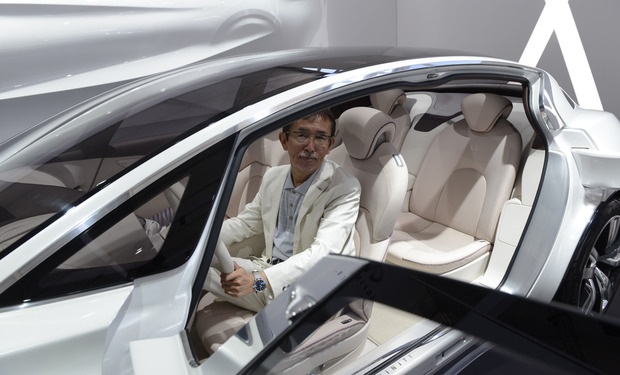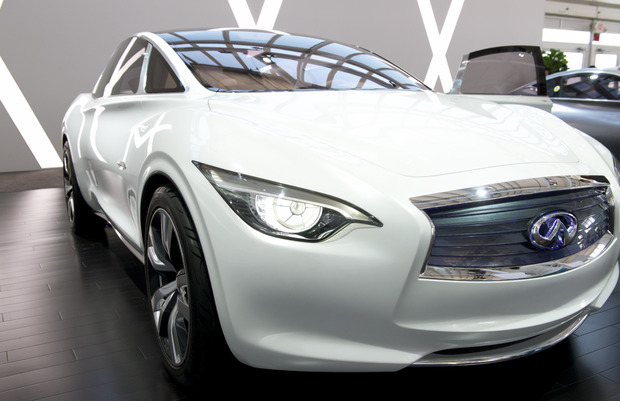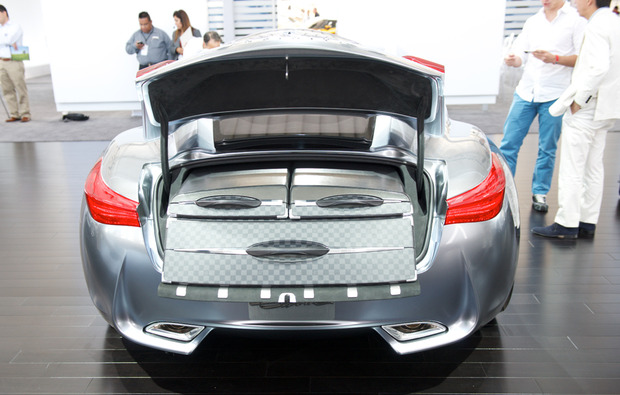Interview: Shiro Nakamura of Nissan, Infiniti and Datsun
A conversation with the Senior Vice President and Chief Creative Officer of Design and Brand Management of the Japanese auto brands


Auto designers are part of a very small community, and those who rise to the top to direct the design of an entire brand (or multiple brands) always intrigue us. By nature, these talented people command the attention of the designers that work for them but, more importantly, they are able to sway the public’s perception for decades, and what they fight for in a product meeting speaks to design’s ability to make or break products.
Shiro Nakamura—the Senior Vice President and Chief Creative Officer of Design and Brand Management of Nissan Motor Company—oversees the design of the company’s three global brands: Datsun (which has just been revived), Nissan and Infiniti. Nakamura can claim responsibility for everything from the GT-R and 370Z to the Altima, Murano, Infiniti’s M and G models and the company’s concept cars. Known for being hands-on and for encouraging limitless imagination in the ideation stages of new models, Nakamura has been with the company since 1999. He now oversees a team of 800 and also holds the role of president for overseas Nissan design studios. I had the chance to speak with him twice in one week; first at the vintage auto show at Pebble Beach, and then at a Datsun/Nissan/Infiniti event.
Nakamura has been strengthening his brands through design for 13 years, while encouraging the introduction of the electric motor and other technological advancements. His designs define one’s initial reaction to the automobiles, and he has a lot to share about inspiring and being inspired.

Evan Orensten: We were both at Pebble Beach, which is a reflection on the past. Why is it important to you and what do you get from being there?
Shiro Nakamura: Simply, I like cars. I like fast cars. It’s not for the purpose of anything business—more my private interests—the festival. And as a car designer, just a pure car designer, it’s for looking at old classic cars. They have to be very good ones, not just old. Classic cars to me are about timeless beauty, given that they were designed 50, 70 or 30 years ago, but still attractive.
It’s the essence of design. It doesn’t matter when it was designed, you can feel the beauty there. I don’t want to design a car that looks like it’s retro. I’m always looking forward at taste and beauty, but you have to know what is the essence of beauty. And simply looking at many beautiful, nice or even very innovative cars—not only beautiful—you can see more. You can absorb many, many things. I think “Yeah, this used to be very innovative, who designed it?”
EO: You have to have that context.
SN: You know the context. If you know who designed it, you know that story, and it’s even more interesting, right? I don’t take directly from a design cue from the old cars. That is not my intention. But you go and see and learn more deeply as a designer.
EO: Was there a car or two that you were really excited to see?
SN: Actually, I like 1960s Italian cars, but I also like 1960s American cars. Those are my favorite as a car designer, like a 1960 Corvette Stingray, Buick Riviera, it was very flamboyant at the time. I was a kid then so that probably influenced me a lot. Growing up in Japan it was hard to see those cars in person—but, by photographs, I learned. And now I’m much older, I look at cars from the 1930s and I discover that it was such an innovative and unique time for design.

EO: It’s amazing to see such a range of cars right next to each other. It’s very overstimulating. You mentioned this notion of the essence of beauty, I think there’s some of that in the overall DNA of the Nissan brands and your vision.
SN: Yeah.
EO: For example, It’s a very big statement to name one of your concept cars “Essence.”
SN: Yeah, (laughing) we cannot do it too often. I think we named it right, and we have three cars. It’s classic.
EO: I’d love to go back to the sense of time. You’re thinking about things that have happened in the past, and you’re inspired by them, and you are day-to-day designing things that are three, five, seven years out. How do you personally think about this time shift, this past/present/future continuum and how that kind of speaks to your ability to lead these design teams?
SN: In many ways, of course, we are looking to the future, for three years, but we are sort of doing fortune telling. We are doing what seems right today. Nobody can tell us three years later what’s going to be. We cannot make additions three years later…so we are designing for the future, but it’s not necessarily the future. We are always looking for something new, always consistently want to create something new. It’s very natural.
EO: Thinking about materials, innovations in carbon fiber and LED lighting have dramatically changed mass market cars. Can you speak to those or other technologies you’re really excited about that are impacting design today?
SN: Exterior-wise, composite materials like carbon fiber, because some of the shape is impossible to form otherwise. I think it’s one of those things we are looking for with carbon fiber for exterior applications. Ttechnology-wise, of course we can easily contribute because we are trained in it, but we get much more freedom to design with it. Any technology gives us much more freedom.
EO: How do you think about the different brands you oversee? How do you lead three separate teams with design studios all over the world? Your head has to be in all three brands all the time.
SN: It’s important to have a very clear differentiation for each brand. Therefore, I think it’s easy enough. I think if you have too many, it’s very hard to manage the brand.
EO: And maybe to organize your brain?
SN: Yeah.

EO: How do you create inspiration for your team?
SN: Well, I have never been in trouble of having designers not inspired. I don’t know. In the beginning we give much more freedom, much more freedom. And then they come up with new ideas.
EO: Do you come to them with a brief saying we should design a new sports car, a new family car?
SN: Of course, of course, much more than that: Target customers, price range, and of course we have a design strategy. They cannot create something that doesn’t look like Nissan, so of course, there’s many, many criteria, but within criteria there’s still lots of freedom.
EO: So the design typically happens then with a specific product brief, like marketing hands you a brief saying this is what we want, now start designing.
SN: We meet together, it’s not just one way. We really do understand that’s our objective. It’s not give them an objective.
EO: Right, it’s really important that the design team is part of that process to determine a new vehicle, even before a sketch happens.
SN: Right, right, I think it’s the project leader on the design team who must understand by himself, the whole concept has to be shared within engineering, design team, planning team, marketing team. Otherwise, you cannot make a very clear concept, and design cannot be clearly reflected. It’s very important that the chief designer, chief engineer, and chief marketing officer consistently share.
Under Nakamura, brands have grown and flourished, even taken on new life. Through our conversations, I gathered a sense that his use of freedom and imagination not only inspire his own staff, but auto buyers too. That sense of curiosity and desire to be actively involved bodes well for the Datsun’s future, a brand which has laid idle for almost three decades.>
Photos by Evan Orensten












